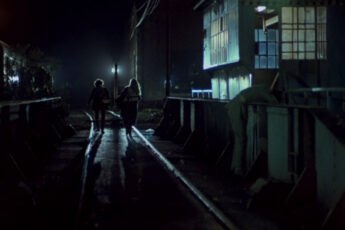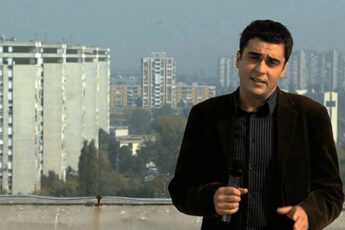
Introduced by David Clark in 1997 in his eponymous book, the term “cinematic city” refers to a range of writings and discussions united by a common interest in exploring the relations between urban and cinematic spaces. Films shot within the built environment may record its current dynamics, architecture, and planning (city as background); consciously use the representational value of specific places for narrative purposes (as character); or comment on the social and political conditions and history of a city (as subject). One could argue that these angles also provide different analytical categories. Films can be studied as (accidental or intentional) historical documents that uncover marginal histories that deviate from dominant narratives, as creative acts interacting with physical, social, and mental spaces, or as discursive tools whose arguments are reinforced by the affective force of the image.
The present issue aims to shed light on different urban stories in the Balkan region, as told through cinematic means. As per historian Mark Mazower, in geographical terms, the “Balkans” originally referred to a mountain range in South-Eastern Europe, before being used to describe the people and lands of a region more commonly known in the 19th century as “European Turkey”, the European foothold of the Ottoman Empire where the Sultan’s subjects of different religions (mainly Muslims, Christians, and Jews) coexisted for hundreds of years. The long period of Ottoman rule was the first historical era to shape the unified urban development of cities in the Balkans. The wars of independence and the Balkan Wars (1912-13) introduced national borders to define the new states and divide the region. Faced with a mixed multicultural and heterogeneous population, the newly appointed officials became aware of the need to promote narratives and ideologies to shape national identities and break with the traditions of the past. This tension between the identity of the new states and the previous way of life is frequently seen in the architectural facade of cities. In the case of Greece, for instance, while Athens, the new capital, was mostly designed from scratch in a neoclassical architectural style to evoke a sense of continuity with antiquity, Thessaloniki had – and still has – architectural vestiges of a time when people of different ethnicities and religions shared and commonly shaped the city’s public space. As Mazower notes in his 2000 history of the Balkans, when Thessaloniki became part of Greece in 1912, the new officials appointed from Athens treated the city as a strange and foreign land and it took a long “Hellenization” process to transform Thessaloniki into a “Greek” city.
The establishment of the Socialist Federal Republic of Yugoslavia was another major historic moment that defined the urban identity of the Balkans. The newly dominant ideology introduced a set of priorities that led to rapid urban transformations and the creation of a new, modern infrastructure. Often, this clashed with a previous way of life, as the Yugoslav people were caught between traditional habits and Socialist or Western ideals, and it was in the public urban space that the political contradictions became most evident. Similarly, the breakup of Yugoslavia and the slow integration of Balkan countries into the “free market” were coupled with a growth in their commercial and tourism activity, which in turn influenced urban land use and architectural design.
Considering that urban space has become the place where different political objectives and ideologies clash and overlap, a close observation of cities in the Balkans may uncover suppressed histories and uncomfortable truths about the region’s social and political past. This seems particularly timely at a moment when right-wing politics are on the rise in the region, with campaigns based on national pride, xenophobia, and ethno-religious divisions taking center-stage. The resulting policies, in turn, reinforce mistrust and estrangement between Balkan neighbors, and seek to undermine the significance of shared cultural ties and habits. The most recent addition to this debate was the decision of the Thessaloniki International Film Festival to discontinue its “Balkan Survey” section, which had existed since 1994, and to replace it with a program focusing on the wider Mediterranean region. As a cultural institution, the festival has historically forged its reputation through politically progressive policies, both in its rhetoric and in its film selection. Its choice to turn its gaze away from the ever-conflicting Balkans to a larger, more innocuous region (the new program includes 36 countries from South-Eastern Europe, the Mediterranean and the Middle East), is a sign that Greece is increasingly distancing itself from Balkan history and culture. This symbolic abandonment of the Balkan may serve as a wake-up call against the normalization of the most divisive national narratives.
The collective amnesia of the shared Balkan past is however, more often than not, countered by everyday practices, architectural remains, and cultural imprints (e.g. linguistic and culinary ones). Spaces, both urban and cinematic, can provide a powerful affective and discursive prism for highlighting these elements, evoking the region’s multiple histories and reactivating marginalized narratives against the formatting of official national ideology.
***
This special issue seeks to shed light on different urban issues that have historically molded cities in the Balkans. Aleksandra Djurasovic and Milan Djurasovic revisit Srđan Karanović’s The Unpicked Strawberries (1975), a popular TV mini-series that depicts the lives and adventures of Belgrade’s youth throughout the 1960s, at a time when the Serbian capital was undergoing rapid transformation while being caught between Western influences and socialist modernism. Ana Grgić examines the “usefulness” of institutional and industrial promotional films shot in Yugoslavia and their role as historical documents that may offer a fresh and nuanced perspective on urban and social issues in Split, the second-largest Croatian city that experienced a large-scale industrialization following the Second World War. Antonis Lagarias retraces Athens’ urban past through the prism of director Nikos Nikolaidis’ unique sci-fi vision that portrays the Greek capital as a post-industrial city in Morning Patrol (1987).
The issue also looks at newer trends in the Balkans. Lea Horvat’s essay discusses how short films in the late 2000s aimed to challenge negative tropes of Yugoslav mass housing in the region by critically and playfully engaging with existing stereotypes to evoke a different, more complex history of urban housing. Finally, David Gomiero Moleno’s close analysis of Kostadin Bonev’s The Sinking of Sozopol (2014) shows how the main character’s identity crisis in the film mirrors the urban transformations that the Bulgarian coastal town is facing with the growth of its tourism industry, a process described as “resortification”.
Antonis Lagarias
Guest Editor




Leave a Comment